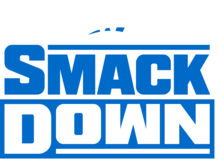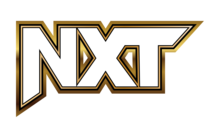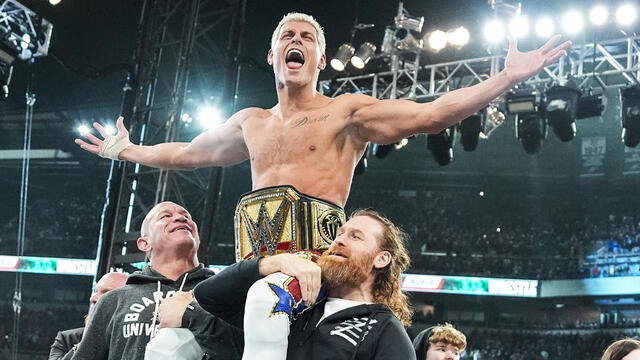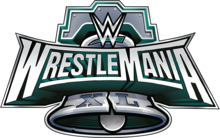
13 'Paul Heyman Guys'

So, what does it take to be a “Paul Heyman Guy”? Every day, I get calls, emails and tweets from people who want to know how to join the select group of those who can genuinely be called “Paul Heyman Guys.”
Sorry to tell you, but there’s no application. No set criterion. No crash course to take. A “Paul Heyman Guy” is someone on whom I’ve focused all my energies and championed their cause and for whom I’ve fought to the point of my own self-detriment.
Watch videos of Paul Heyman with his "Guys"
I am, admittedly, even to this day, a great admirer of those who possess the talent to change this industry. I am, at heart, a fan. And as a fan, my heart beats faster when I’m in the presence of greatness. Not just a great wrestler. Not just a great entertainer. Not just a great personality. True, through-and-through greatness — the kind that must be developed, nurtured, crafted and then turned loose onto the WWE Universe.
Ever since CM Punk delivered his first “pipe bomb” two years ago and alerted the world to the behind-the-scenes term “Paul Heyman Guy,” many have wondered “well, just who are these rare individuals?” For the very first time, let’s examine that list.
Ladies and gentlemen, my name is Paul Heyman. And these are my “Guys”!
CM Punk
The list starts with the man who popularized the term. The man who was the reigning, defending WWE Champion for 434 consecutive days. The Best in the World. CM Punk.
Watch CM Punk drop a "pipe bomb" and call himself "a Paul Heyman Guy"
In 2005, CM Punk was the hottest free agent in the world, having wrestled all across the globe, most notably for the Ring of Honor organization. He was signed by WWE, to be blunt, simply because he had great buzz. No one producing Raw or SmackDown knew what to do with this extraordinary talent who was determined to become recognized as The Best in the World. Yes, even then, Punk’s ambition was to be No. 1. He never imagined anything less for himself.
Unfortunately, no one else in WWE shared that vision. You’ll be reading that sentence, and similar ones to it, a lot today.
Punk was sent to WWE’s developmental organization, which at the time was in Louisville, Ky., and I was producing the television show. There was no doubt in my mind I had just been handed a future WrestleMania main eventer, and I was astounded at the fact that no one in in the WWE management agreed with my assessment. I fought for CM Punk because I believed in CM Punk both personally and professionally, and even after I left WWE in December 2006 (and some would say I martyred myself at the altar in my belief of CM Punk’s greatness), we remained very tight because our friendship transcended WWE and the entire industry.
A lot of people try to categorize the nature of my relationship with CM Punk. I’m here as a friend, a support staff, a lobbyist for CM Punk to receive the respect that he has earned and deserves. If for no other reason than because he was the reigning, defending WWE Champion for 434 consecutive days. CM Punk has earned the distinction of being known as The Best in the World. I’m here to ensure he is recognized as such, as I’m going to assist him in that goal, with or without anyone’s blessing.
If you must know why, I’m happy to enlighten you. It’s because, with all my heart and soul, I’m a “CM Punk Guy!”
Watch Heyman revealed as Punk's driver
Brock Lesnar
I know everyone is looking for a sinister conspiracy that Brock and I must have about taking over the WWE Universe, but the truth of the matter is that (and as unpopular as this is for me to say and you to read), we’re just the best of friends. Period.
Sorry, folks. I know how envious you all must be of the fact I am included in the inner circle of a truly reclusive individual, but I can proudly state with no fear of contradiction, I’m Brock Lesnar’s confidante.
Watch Brock's destructive WWE debut with Heyman by his side
When Brock debuted in WWE in 2002, I was both his on-air “agent” (I just can’t bring myself to use the old school term “manager”) and his behind-the-scenes producer. In working so closely with each other, we found that despite our different backgrounds, this once-in-a-lifetime athlete who grew up on a dairy farm in Webster, S.D., had an awful lot in common with the smart aleck son of a Jewish personal injury attorney from New York. As ambitious as the two of us were (both individually and together), our priorities were exactly the same. No matter what, our children came first.
Based on that common mindset, Brock and I forged a friendship that lasted even after we both were gone from WWE, and through Brock’s legendary run in UFC. We even wrote a book together about his life and enjoy, to this day, a friendship that transcends the WWE Universe.
I recently said I’ve been riding Brock Lesnar’s coattails for 10 years. You can judge for yourself whether I was kidding. Either way, I can honestly tell you it’s been one hell of a ride!
Print your own official photo of Brock & Heyman from 2002 | Watch Heyman return to WWE as Lesnar's adviser
Big Show
In 2002, Big Show’s career had hit rock bottom. Instead of being a dominant, 7-foot tall, 500-pound giant, he had fallen into such a rut that he was the weekly whipping boy and laughingstock for The nWo on Monday Night Raw. SmackDown needed someone to present a challenge to Brock Lesnar.
“The Next Big Thing” was unbeatable, and much like when Mike Tyson was crushing people inside of one round, the public didn’t believe anyone could stand up to Brock.
Enter Big Show.
Presented with a “last chance at greatness,” this real-life giant took advantage of the opportunity to re-invent himself and he never looked back. At Survivor Series 2002, Big Show was crowned the brand-new WWE Champion when he became the first man ever to defeat Brock Lesnar. Talk about being in the right place at the right time. There he was, this mass of humanity, standing in the middle of the ring at The World’s Most Famous Arena, Madison Square Garden, having conquered the ultimate conqueror.
Watch Heyman turn on Lesnar to help Big Show win the WWE Championship
I didn’t discover Big Show. I didn’t debut him. I didn’t oversee his development. But I was also in the right place, at the right time, and I was there for his rebirth as a top-tier WWE Superstar. If for no other reason besides that, our list features many Superstars, but only one giant. And he’s a “Paul Heyman Guy”!
Rob Van Dam
Rob Van Dam is a most unique individual, and that’s the type of personality I like to seek out when directing my focus on a particular talent in this industry. In the 1990s, both Mr. McMahon and Ted Turner had their own visions of what a top star in professional wrestling would be, and Rob Van Dam simply didn’t fit the mold.
Watch RVD win the WWE Title as Heyman counts the pinfall
While they saw an unorthodox athlete whose style could not be defined (and therefore, according to the mindset of the time, could not be showcased), I saw an unparalleled performer in Rob Van Dam. I must admit, the narrow-mindedness of the big honchos in sports-entertainment during the Monday Night War was a blessing for ECW, because it enabled us (and yes, I’ll say the dreaded egotistical word, “ME”) to appear as RVD’s godsend.
No one in WWE or WCW would have taken the time to develop his persona, let alone devoted the energies necessary to help Rob himself find that persona. Since WWE and WCW were so obsessed with putting their own personal stamp on everyone that appeared on their TV shows, I knew the key to developing RVD was to simply let Rob Van Dam ... be Rob Van Dam!
The popularity of RVD was always based on the fact the audience knew they were getting someone real. Someone genuine. Someone who was open with his audience, true to his word, and was unabashedly full of himself ... and with good reason. In a Universe filled with unique personalities, Rob Van Dam was truly “one of a kind!”
Watch Heyman present Van Dam with the ECW Championship
"Stone Cold" Steve Austin
The right guy in the right place at the right time, and I get all the credit for it. Wow. If you listen to “Stone Cold” Steve Austin, and I always do, it makes me want to be a “Paul Heyman Guy.” I managed Steve during our Dangerous Alliance days in WCW in 1991-'92, and even wrote an article for the WCW Magazine back then proclaiming Steve was going to be the biggest star in the industry by the end of the decade. I didn’t have a crystal ball. I wasn’t a modern-day Nostradamus. It didn’t even point to me being some brilliant assessor of talent. Where all others were blind, I was fortunate to simply see!
Watch Paul E. Dangerously form The Dangerous Alliance with Steve Austin
When Steve came to ECW, his head was so filled with WCW’s backward mentality, he couldn’t think straight. I know Steve loves to give me credit for helping him “find ‘Stone Cold’ within himself,” but the fact is Steve was going to become the biggest star in pro wrestling history no matter what. All he needed was just one moment in time to prove it to every wrestling fan, everybody in upper management, and (most importantly) to himself. I just happened to be the one that was blessed enough to afford him the opportunity to find himself. The wildest thing about it is that he found himself while on camera.
Watch Steve Austin vent his frustrations in ECW | Watch Austin tell the ECW fans what's on his mind
If you look in Steve’s eyes during those legendary interviews in ECW, you noticed that somewhere during those interviews, he himself realized that he was indeed going to become The Best in the World. Hey, that sounds a bit familiar, doesn’t it? “Oh hell yeah!”
Tazz
Like most “Paul Heyman Guys,” Tazz was an extraordinary talent that no one would take the time to believe in. The pro wrestling landscape in the mid-1990s was “the land of the giants,” and if a performer wasn’t 6-feet tall, 260-plus pounds, no executive would believe the wrestler could be a main eventer. Tazz was 5-foot-8, 248 pounds. He could barely get anyone in WWE or WCW to take his phone call.
The mid-1990s saw the emergence of mixed martial arts as a sport, and the concept of a 175-pound athlete choking out a 300-pound opponent came into vogue. We in ECW realized early on that while Tazz’s physical stature was not that of a giant, his personality surely was. As a main eventer, Tazz could be (and certainly was) a serious box-office attraction.
Tazz was also one of the most believable talkers in the industry at the time, and when he openly challenged the champions from any other organization to bring their tail to ECW, where he’d happily (and easily) choke them out, people believed he could do just that.
Watch Tazz face off with Sabu in ECW
I used to get phone calls at all hours of the night from people in WWE and WCW (and even from some in Japan) saying “You can't have this guy make grandstand challenges against our champion!” It wasn’t so much that ECW's in-house tough guy was calling out their top dogs. It was the fact our in-house tough guy was 5-foot-8, 248 pounds.
“Feel free to send your guy, and he can fight my guy,” I’d tell ’em. That usually got the response of either a belly chuckle or a dial tone. It didn’t matter to me. I knew what I had in Tazz. I had pro wrestling’s first tap out artist, a no holds barred fighter who everyone believed was everything he (and ECW) said he was.
When Tazz made his debut at the 2000 Royal Rumble in Madison Square Garden, he got one of the greatest reactions for a debuting Superstar in WWE history. To many, that was a demonstration of the popularity of ECW, and the believability of Tazz.
Watch Tazz speak candidly about Paul Heyman | Watch Tazz's WWE debut in Madison Square Garden
I hate to say “I told you so.” But ... I told you so!
The Miz
In 2006, The Miz was a frustrated, teenybopper, goody two-shoes in one of WWE’s developmental systems in Atlanta, a Tough Enough runner-up designed to lure in the MTV generation. Someone take me out of my misery now. Actually, someone really needed to take Miz out of his misery. And that someone is (I bet you can guess where this is going) ... ME! If you guessed that correctly, good for you. What do you want, credit or something?
I plucked The Miz out of the Atlanta developmental system and brought him to OVW in Louisville, Ky., where I was producing the TV show which starred, of course, The Best in the World, CM Punk. It was such a no-brainer. Miz had a naturally acerbic, uber-charismatic personality that was just aching to be unleashed. If you’re looking for me to say “I taught Mike Mizanin how to be The Miz,” then you still don’t get it, do you? I turned the camera on this gifted young man and told him to just be himself. And underneath all the layers of smiley 8x10s, shaking hands and kissing babies laid an uninhibited “Miz-erable” human being who didn’t really seek adulation, just success.
Watch The Miz's rare debut in Ohio Valley Wrestling
It didn’t take Mike Mizanin long to find The Miz, and it won’t take the next Superstar I get my hooks into any length of time to find his true calling, his real self and his inner main eventer. They may not know it yet, but I have my eye on the future of WWE. I can sense things in people others don’t realize, see things in Superstars they themselves can't grasp quite just yet. That’s the magic of what I do. Because whether you like this fact, whether you believe it to be true or just a grandiose statement, whether you think this is hype, hyperbole or Heyman:
My name is Paul Heyman, and there are plenty of “Paul Heyman Guys” out there in WWE right now ... even if some of them don’t know it yet!
Mick Foley
Mick Foley came to ECW as part of a settlement when I filed a lawsuit against WCW and never really left. As soon as Cactus Jack appeared before the hardcore audience in The Land of Extreme, he knew in his heart he was home. But all good things must come to an end, and after a two-year run as an iconic hero in the original incarnation of ECW, Mick was starting to just waste his time. He was just coasting, at an A-level, but coasting nonetheless. Mick wasn’t breaking any new ground. He wasn’t innovating any new style. He wasn’t doing anything revolutionary. For most, that’s not a problem. Do the job the audience expects from you, and everyone goes home happy.
Watch Heyman speak about Cactus Jack and Foley's response
But Mick Foley had so much more to offer. There was a brilliant, multilayered, bizarre, complex, riveting persona living inside Foley that could change the way interviews were shot, produced and presented on a global basis. Not just in pro wrestling or sports-entertainment, but Mick was so talented, his interviews could open the eyes of television producers and executives worldwide.
I exaggerate not! Just watch footage of Mick Foley delivering the anti-hardcore interviews in ECW. It’s mesmerizing. No one had ever done anything like it before. And, I dare say, all others who have tried to equal or replicate it have failed miserably by comparison.
Watch the infamous "Cane Dewey" interview | Watch Cactus Jack's final ECW match
Here comes the best part: Mick gives me a ton of credit for it all. He did so in his first book, and he even did so last week on Monday Night Raw. And yet, with all humility, I must candidly admit, I beg to differ. If a head coach in football has a quarterback that can throw the ball into the end zone every single time you place the ball in that quarterback’s hands, is that head coach a genius? Or a “mad scientist”? Or a great producer? No, that coach just knows the right guy who can score touchdowns at will. I turned the camera on Foley, lit him from underneath to give him a more horror movie–like appearance, gave him a concept as to what the message would be and then sat back and watched a master create his own art.
I don’t deserve credit for the emergence of Mick Foley as one of the single most brilliant interview stars in the history of this industry. I’m the head coach who had a quarterback who could score touchdowns every time I placed the ball in his hands.
All I did was give him the ball.
Rey Mysterio
In 1995, the landscape of sports-entertainment in the United States was dramatically different. No one of Rey Mysterio’s size or aerial ability had ever been featured in this country. The highest flier Americans had seen up until that point was “Superfly” Jimmy Snuka, and the most famous luchador was Mil Mascaras, who really never left his feet except for a bodypress off the top rope.
When ECW suffered a dramatic talent raid at the hands of WCW, many thought it could have been the death of our company. Our backs were against the wall. How could Extreme Championship Wrestling come back from a devastating blow? I knew our only hope was to come out blasting and make the next major show even better than anything anyone had ever seen before. We literally had to show the world we were still the innovators of new styles. Groundbreaking concepts were used on TV, unmatched ferocity was presented on the mic and the most cutting-edge style was presented in the ring.
Watch Rey vs. Psicosis in ECW: Match 1, Match 2, Match 3
I reached out to Konnan in Mexico, and without hesitation, he sent Rey Mysterio and Psicosis to South Philly for the next ECW Arena show. Konnan guaranteed me their matches would not only be state of the art, but also that nothing could match Rey vs. Psicosis in the United States. The ECW audience, which lived by the philosophy of “accentuate the strengths and hide the weaknesses,” never paid attention to the fact that Rey Mysterio wasn’t a bodybuilder, or 6-feet tall, or 300 pounds. The ECW audience saw a magnificent performer the likes of which the United States had never seen. Mysterio not only lived up to my expectations, but he also single-handedly opened up the U.S. market to the concept of cruiserweights. And he turned one of ECW’s darkest hours into one of our greatest triumphs. Gracias, “Paul Heyman tipo”!
"Ravishing" Rick Rude
In fall 1991, WCW was reeling from the loss of “Nature Boy” Ric Flair. Someone had to fill the void. A new top star was needed. So the Turner-owned organization made a big move. They signed former WWE Intercontinental Champion “Ravishing” Rick Rude.
At the same time, I had one of my many fallings-out with WCW management, and was coming back (common theme: right place, right time) as the CEO of The Dangerous Alliance. Even back then, I avoided the term “manager.” The group was a blatant attempt to one-up the past, as a new Four Horsemen–style group, this time revolving around the top star (Rude) and his maniacal sidekick (that would be me, Paul E. Dangerously).
Our pairing had all the makings for a perfect storm: A company in a chaotic free-fall following the unpopular loss of its top star; a remarkable talent with something to prove and a chip on each shoulder; and a young upstart, frustrated with the system, looking to usher in a new era of reality-based interviews and progressive in-ring style.
Rude was obsessed with being the very best in every way. He knew he was at the peak of his ability to exploit his enormous physical gifts, and I can’t say I’ve ever met a smarter person inside the ring until CM Punk walked through the doors in 2005. Rude was a masterful main eventer. I often found myself just staring in disbelief at how easily he could control the crowd, manipulate emotions and make people clamor for Sting or Ricky Steamboat to avenge the dastardly deeds of The Dangerous Alliance. When you consider the amazing compilation of talent under my umbrella in 1991 and ’92 (the group also included Steve Austin, Arn Anderson, Bobby Eaton, Larry Zbyszko and Madusa), the fact Rick Rude is still so prevalent in my memories of that era speaks volumes.
Watch Heyman get involved in the wild conclusion of Rick Rude vs. Sting
Rude’s career and his life were both cut short. I don’t think he ever achieved all he set out to do in either WCW or WWE (where he was managed by Bobby “The Brain” Heenan). But during that brief but memorable run together in WCW, I witnessed true greatness. I don’t think Rude was ever better than when he was U.S. Champion during his tenure in The Dangerous Alliance. I was honored to be able to call him a “Paul Heyman Guy.” After all, he was “simply ravishing!”
Bam Bam Bigelow
Scott Charles Bigelow was an amateur wrestler, bouncer and bounty hunter from Asbury Park, N.J., who either had to find employment quickly or spend the rest of his adult life in jail.
I was 18 years old and happened to be taking photographs at The Monster Factory wrestling school in New Jersey on Bigelow’s second day as a student. He was 6-foot-3, 390 pounds, already tattooing his head, and his ability in the ring was freakish. Bigelow was akin to a child who can listen to Mozart and then walk up to a piano and effortlessly play the symphony he just heard. The trainers would show Bigelow a sequence of moves, and he could immediately get into the ring and duplicate what he had witnessed. There can’t possibly be more than a handful of people that have ever inhabited this planet that were more naturally inclined to become a professional wrestler than Bam Bam Bigelow.
Watch Bam Bam Bigelow win the ECW Title | Watch Bigelow and Tazz crash through the ring
As a photographer, I would travel up and down the east coast to wrestling matches with Bigelow, who paid his wrestling school tuition by working on a ring crew with some of the other students from The Monster Factory. When I started producing and promoting Friday night events in 1985 at the world’s most famous nightclub, Studio 54 in New York City, I desperately wanted to produce a wrestling event at the end of the summer. So I cut a deal with Jim Crockett Promotions to feature Ric Flair and Dusty Rhodes on a press-filled night in midtown Manhattan that would also feature the professional wrestling debut of Bam Bam Bigelow. I had Bigelow fight four opponents, and he mopped the floor with all four of them.
Print the rare flyer for Bigelow's debut | Visit Bam Bam Bigelow's Alumni profile
While many in the industry make their debut in developmental areas or high school gyms or VFW halls, Bam Bam Bigelow made his debut in an event that got covered by USA Today, The New York Times, The Daily News and The New York Post and talked about on TBS by Ric Flair and Dusty Rhodes. Not a bad way to kick off a career, but what else would you expect from a “Paul Heyman Guy”?
The Public Enemy
When I took over producing ECW, I knew the first featured act had to present the embodiment of the Extreme vision to the audience. “Flyboy” Rocco Rock and Johnny Grunge were the two least likely performers ever to be presented as hoodies. They were the most mismatched pair behind the scenes you could ever imagine, and for every wrong reason in the world, that’s what made them so great.
Neither Rocco Rock nor Johnny Grunge had ever been exposed to a significant wrestling audience before I debuted them as The Public Enemy, so when we blasted them out during the opening match ECW UltraClash on Sept. 18th, 1993, the ECW Arena, the audience had to accept them as the personas we were presenting because they never saw them in any other light.
Watch The Public Enemy make their debut at the ECW Arena
When people look back at the early days of ECW, it’s clear the diversity of personalities was one of the things that grabbed so many people’s attention, and helped the company grow into a global phenomenon inside the remainder of the decade. Make no mistake about it, though. The early days of ECW were based on the emergence of Shane Douglas as our “Franchise” player, the phenomenon known as Sabu, the unique announcing of Joey Styles and the poster boys for Extreme, “Flyboy” Rocco Rock and Johnny Grunge, The Public Enemy.
Joey Styles
Joey Styles was someone with as much product knowledge as any other announcer out there, an enthusiasm that could not be touched and a desire to fulfill his dream of being a pro wrestling announcer. Yet Joey did not have one, single, solitary opportunity to even sink or swim, do or die on his own, get the one shot to prove himself worthy. The first day I met Joey, he told me he wanted to be a play-by-play announcer, and I thought the day he graduated college someone would immediately sign him up. And yet, no one would give this brilliant young man a chance. It’s a common theme among “Paul Heyman Guys.”
Watch Heyman and Joey during ECW's early days
Joey’s biggest night was April 13, 1997. It was ECW’s first pay-per-view, and you have to understand the television industry was much different back then. UFC couldn’t get cleared, and was on the verge of extinction. Only WWE and WCW had the power to present live pay-per-view events. And much like the pro wrestling business itself, pay-per-view was a closed-door industry. ECW couldn’t get in.
But through a radical campaign initiated by ECW fans, we got cleared to go live on pay-per-view on that fateful Sunday night. And since the PPV companies thought they were doing us a favor, they figured they would dictate some terms. Small terms, nothing substantial. Things like “You'll have a color commentator with Joey.”
OR ELSE WHAT?
“Or else you won’t air on pay-per-view!”
They weren’t kidding. The pay–per-view companies wanted to control the product from the get-go, and I was too much a rebel leader to bend. “Then don't air us. When we go live (an hour later than everyone else, by the way), Joey Styles is hosting this show. All by himself. With no one else. It’s what our fans want, it’s what they expect and it’s what Joey has earned.”
Read the inside story of ECW Barely Legal
In typical ECW “miracle” fashion, the generator blew a few moments after we went off the air. But we had already signed off. ECW’s first pay-per-view was a reality. The emotion in the back was something I have yet to find the words to convey or to describe. Yet of all the tears being shed, all the hugs being given, all the vows of “I’ll never forget this moment for the rest of my life,” the thing I remember most was a weeping, uncontrollably sobbing Joey Styles making it to the top stage (from where I was producing the show) and hugging me with every bit of strength in his body. He did it. He pulled it off. And he did so, by the way, brilliantly.
I’ll never forget that moment (you knew this was coming, right?) for the rest of my life!
WWE Shows Latest Results
Raw results, May 13, 2024: Jey Uso and Gunther advance to face each other in the King of the Ring Semifinal next week
Full ResultsSmackDown results, May 10, 2024: The Viper strikes AJ Styles to advance to the King of the Ring Quarterfinals
Full ResultsWWE NXT results, May 14, 2024: Tony D'Angelo defeats Charlie Dempsey to win the NXT Heritage Cup!
Full Results


















